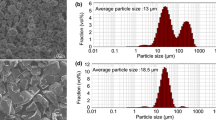Abstract
The purpose of this research was to systematically study the influence of peak-shock pressure and second-phase reinforcement on the structure/property response of shock-loaded 6061-T6 Al-alumina composites. The reload stress-strain response of monolithic 6061-T6 Al, used as a baseline for comparison, showed no increased shock hardening compared to the unshocked material deformed to an equivalent strain. The reload stress-strain response of the shock-loaded 6061-T6 Al-alumina composites exhibited a lower reload yield strength than the flow stress of the starting composites. The degree of strength loss was found to increase with increasing shock pressure. Wavespeed measurements of shock-prestrained specimens showed no degradation compared to unshocked specimens, indicating that particle cracking had not occurred under shock. This result was supported by optical metallography, which did not reveal cracked particles or particle decohesion in the shock-prestrained samples. The reload stress-strain response of the shock-prestrained composites, after resolutionizing and T6 reaging, showed that the composites recovered their full as-received preshock stress-strain responses. This result supports the finding that degradation in reload strength was attributable to matrix microstructural changes resulting from the shock. Transmission electron microscopy (TEM) examination of the shock-loaded microstructures revealed that the matrix regions adjacent to the particle/matrix interface had undergone significant recovery and partial recrystallization resulting from the shock. This type of near-interface substructure is in stark contrast to the heavily dislocated near-interface dislocation substructure of the as-received composites. The loss of dislocation density(i.e., strain hardening) in the near-interface matrix region, resulting from the shock, highlights the importance of the thermally introduced dislocation substructure changes in establishing the strength of metal-matrix composites (MMCs).
Similar content being viewed by others
References
M. Taya and R.J. Arsenault:Metal Matrix Composites, Pergamon Press, Oxford, 1989, pp. 42–48.
I.A. Ibrahim, F.A. Mohamed, and E.J. Lavernia:J. Mater. Sci., 1991, vol. 26, pp. 1137–56.
S.I. Hong and G.T. Gray III:Acta Metall. Mater., 1992, vol. 40, pp. 3299–3315.
S.I. Hong, G.T. Gray III, and J.J. Lewandowski:Acta Metall. Mater., 1993, vol. 41, 2337–51.
D.A. Jones and J.W. Mitchell:Phil. Mag., 1958, vol. 3, pp. 1–7.
W. Funk and E. Blank:Metall. Trans., 1988, vol. 19A, pp. 987–98.
M. Taya and T. Mori:Acta Metall., 1987, vol. 35, pp. 155–62.
M. Vogelsang, R.J. Arsenault, and R.M. Fisher:Metall. Trans., A 1986, vol. 17A, 379–89.
D.C. Dunand and A. Mortensen:Acta Metall. Mater., 1991, vol. 39, 127–39.
G.T. Gray III: inHigh Pressure Shock Compression of Solids, J.R. Asay and M. Shahinpoor, eds., Springer-Verlag, New York, NY, 1993, pp. 187–215.
G.T. Gray III:High-Pressure Science and Technology—1993, AIP Conf. Proc, Colorado Springs, Colorado, S.C. Schmidt, J.W. Shaner, G.A. Samara, and M. Ross, eds., American Institute of Physics, 1994, vol. 309, pp. 1161-64.
L.M. Baker:J. Comp. Mater., 1971, vol. 5, pp. 140–62.
M.A. Meyers, L.W. Meyer, K.S. Vecchio, and U. Andrade:J. de Physique, Colloque C3; suppl. toJ. de Physique III, 1991, Oct., pp. 11-17.
G.T. Gray III:Shock Compression of Condensed Matter—1989, S.C. Schmidt, J.N. Johnson, and L.W. Davison, eds., North-Holland Publishing Co., Amsterdam, 1990, pp. 407–14.
G.T. Gray III and P.S. Follansbee:Shock Waves in Condensed Matter 1987. S.C. Schmidt and N.C. Holmes, eds., North-Holland Publishing Co., Amsterdam, 1988, pp. 339–42.
S.I. Hong, G.T. Gray III, and J.J. Lewandowski:Scripta Metall, 1992, vol. 27, pp. 431–36.
Author information
Authors and Affiliations
Additional information
This article is based on a presentation made in the symposium “Dynamic Behavior of Materials,” presented at the 1994 Fall Meeting of TMS/ASM in Rosemont, Illinois, October 3-5, 1994, under the auspices of the TMS-SMD Mechanical Metallurgy Committee and the ASM-MSD Flow and Fracture Committee.
Rights and permissions
About this article
Cite this article
Vecchio, K.S., Gray, G.T. Shock-loading response of 6061- T6 aluminum metal-matrix composites. Metall Mater Trans A 26, 2545–2553 (1995). https://doi.org/10.1007/BF02669412
Published:
Issue Date:
DOI: https://doi.org/10.1007/BF02669412




